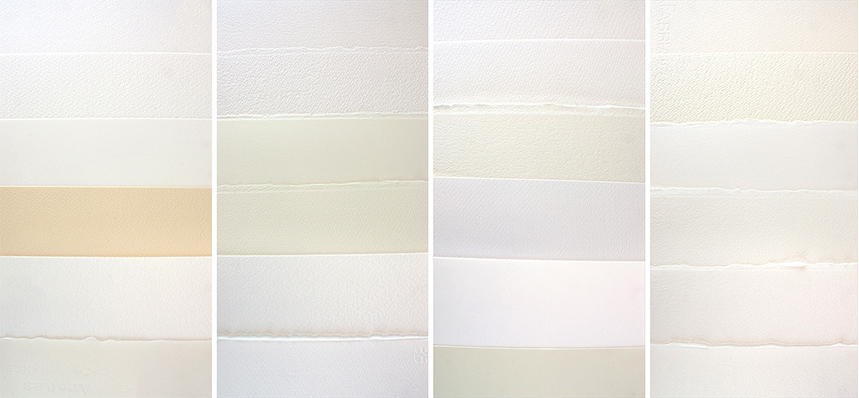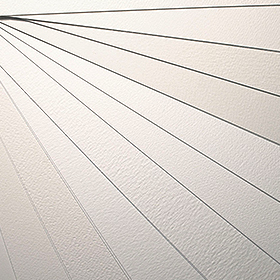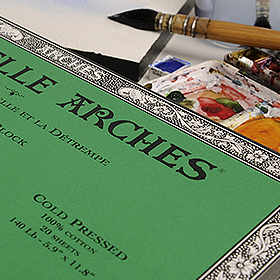Choosing Your Watercolour Paper

Choosing the right paper for your purpose will usually be based upon personal preference for a particular surface, closely followed by the colour of the sheet, whether you would like a loose sheet or pad and last but not least, the weight of the paper. One important thing to bear in mind when selecting a watercolour paper is that the surfaces only relate to one another within a particular manufacturer's brand of paper. A Hot-Pressed surface will not retain the same smoothness from brand to brand. You will find, for example, that Hot-Pressed Saunders Waterford Paper will differ in its smoothness to an Arches Hot-Pressed sheet. For those looking to directly compare different brands of paper we stock a Mini Watercolour Paper Starter Pack, which offers 1/8th Imperial sheets of a selection of watercolour papers that we stock at a very affordable price.
Colour of the Paper
Traditional watercolour papers are white in colour as this allows the maximum amount of light to be reflected back through the watercolour wash. This translucency and luminosity on white paper is what gives watercolour painting its distinctive charm. Although most watercolourists favour a white paper, some prefer to use a slightly tinted paper, like the Bockingford Tinted Watercolour Paper, to mellow the painting's tone.
Traditional white watercolour papers do vary in their whiteness from manufacturer to manufacturer. A white paper can vary from a bright white to a creamy off-white. Some brands, such as Saunders Waterford Watercolour Paper, now offer a Saunders Waterford High White version of their traditional white papers. Although it should be noted that these high white alternatives are still not a stark, bright white. It should also be noted that 'High White' papers are only brighter in their whiteness compared to their Traditional White equivalents in the same range. For example, Saunders Waterford High White is graded in its whiteness compared to Saunders Waterford Traditional White, and may not be as white as Bockingford watercolour paper.
It is also worth bearing in mind that lesser, student quality papers often make use of OBAs (Optical Brightening Agents). These agents are added to increase the amount of blue light that the paper reflects, thus making it appear brighter to the eye. These artificial brightening agents can yellow over time which may negatively impact on the appearance of your painting.
The image below compares the whiteness of the papers included in our Mini Watercolour Paper Starter Pack:
Included in the image, top to bottom, left to right: | |||
1. Bockingford 140lb NOT | 7. Arches 140lb NOT | 13. Millford 140lb NOT | 19. Fabriano Artistico 140lb NOT |
2. Bockingford 140lb Rough | 8. Arches 140lb Rough | 14. Saunders High White 140lb Rough | 20. Fabriano Artistico 140lb Rough |
3. Bockingford 140lb HP | 9. Saunders Waterford 140lb HP | 15. Fabriano Artistico 300lb HP | 21. Winsor & Newton Professional 140lb HP |
4. Bockingford 140lb Cream | 10. Saunders Waterford 140lb NOT | 16. Fabriano 5 140lb NOT | 22. Winsor & Newton Professional 140lb NOT |
5. Bockingford 200lb NOT | 11. Saunders Waterford 200lb Rough | 17. Botanical Ultra Smooth 140lb HP | 23. Winsor & Newton Professional 140lb Rough |
6. Arches 90lb HP | 12. Saunders High White 140lb NOT | 18. Fabriano Artistico 140lb HP | 24. Ken Bromley Practice Paper 130lb NOT |
Weights of Paper
There are three commonly available weights of watercolour paper; 90lb (190gsm), 140lb (300gsm) and 300lb (640gsm), although some manufacturers made paper that falls in between or outside these measurements. You may have noticed that paper can be measured in both imperial (lb) and metric (gsm) measurements; in each case the lower the number the lighter the sheet will be. The heavier the watercolour paper, the less it is likely to cockle when watercolour paint is applied. The heaviest papers are the most costly. Watercolour boards are also available, such as the Langton Prestige Watercolour Board and Langton Watercolour Board. These surfaces provide a thicker painting surface on a laminated backing board making them ideal for those who wish to use repeated washes.
The most commonly selected weight of paper is 140lb/300gsm, which should not require stretching if minimal amounts of water are applied. However, if you favour wet or repeated washes in your work we would recommend stretching anything under 200lb/425gsm as stretching will make the surface less likely to cockle. For more information about stretching paper why not read our Guide to Soaking and Stretching your Watercolour Paper.
Format of the Paper
Another choice you will be faced with is which format you would like to buy your paper in. Most papers are commonly available in loose sheets, pads and blocks in a wide variety of sizes.
Loose Watercolour Paper Sheets
Loose sheets of watercolour paper are most commonly available in Full Imperial size at 5 sheets per pack. Imperial is an old unit of paper measurement and a full imperial sheet will measure 30 x 22” (76 x 56cm). Some brands of paper may come in at just a little under this size, such as the Botanical Ultra Smooth and Fabriano 5 NOT so it worth double checking the product description just to make sure that it fits your requirements. We also offer a paper cutting service free of charge. At no extra cost, we will be able to cut your full imperial sheets into either ½ Imperial (15x22”/56x38cm) or ¼ Imperial (11x15”/ 38x28cm). If you choose to have your paper cut to ½ Imperial you will receive 10 sheets in total, and if you choose to have it cut to ¼ imperial you will receive 20 sheets. If you opt to have your paper cut then you will alter the amount of deckle edges each sheet has. |
> View our Loose Watercolour Paper Sheets
Watercolour Paper Pads
Watercolour Paper Pads offer a great way to keep your watercolour sheets bound together for easy transportation when painting out-and-about. Pads can either be bound with gum or a spiral in either a landscape or portrait format. It is worth noting that a Gummed Pad is only gummed at one end. Bound pads are also great if you wish to complete multiple paintings on the go, as the pages can be leafed through, unlike in a Block. |
> View our Watercolour Paper Pads
Watercolour Paper Blocks
Watercolour Paper Blocks are a fantastic choice if you do not have time to stretch your watercolour paper. Blocks are glued on all four sides, unlike a Gummed Pad which is only sealed at one end. The glued sides mean that the paper is unlikely to cockle and therefore does not require stretching before use. Once your painting is complete and dry you can remove it from the block by using a blunt knife. Commonly there is a small gap in the adhesive on one side, this gap allows you to slip in a knife and release your painting. |














